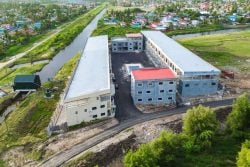Dear Editor,
I respond to David Patterson’s letter `Every Guyanese will support the bridging of every river in Guyana but not as a burden to its citizens’ (SN 8/29/2024) as a technocrat that led the execution of the Berbice Bridge project under the Presidency of Bharrat Jagdeo and witnessed its commissioning in December 2008. I can also comment from having been actively involved in advising on the RFP that tendered the high fixed bridge currently being constructed to replace the floating Demerara Bridge.
My response to specific parts of his letter is in italics.
The infallible ones are at it again. In a letter in today’s Stabroek News (SN), the letter writer sought to justify the PPP’s past decision to construct a floating bridge crossing the Berbice River. Now 15 years later, they are seeking to dismantle that bridge and replace it with a fixed concrete bridge. Sadly, the letter only magnifies the short-sightedness of the government – all at the expense of the residents of Berbice.
The Berbice Bridge Company Inc (BBCI) has a 21-year concession starting in June 2006. It therefore ends in June of 2027 unless mutually extended. A new fixed bridge will take years to be procured and constructed; a new fixed bridge will likely not be ready until end 2027 and will therefore coincide with the end of this concession by which time all financing will be repaid to the investors. It is a term of the concession that the bridge reverts to the GOG at no cost at the end of the concession. It is not unusual for a floating bridge to have a 20 year life and be depreciated accordingly. Of course, all investors have to be satisfied financially per the Concession Agreement.
The Demerara bridge extension of life beyond 20 years has been bought with many times the original investment being spent on capital maintenance.
Every Guyanese, inclusive of the opposition, have always been supportive of bridging all our rivers, not only the Berbice River since this is a progressive measure. However, we have always cautioned that our support was conditional on data which shows the technical and financial sustainability of such a project. We must ensure the citizens of Berbice, as well as the rest of the country, receive value for money since our history is replete with short-sighted, unplanned and eventually failed projects implemented by the PPP.
As I recall, like any major PPP project, be it Marriott, Amaila, or the Berbice bridge, there was no shortage of criticism by the political opposition. The papers of the day during the Feasibility and financing process, is replete with many examples of such critics and detractors. You would be aware that the Louis Berger Feasibility Study itself was shared with the Parliamentary Committees. This study clearly showed the technical and financial sustainability of the project. Without these, it would have been very diU’icult to secure the US$40 M for the bridge that was raised from our private sector (banks, insurance companies, pension funds, and major corporate investors). The record will also show that the financial modelling and performance of the bridge was conservative, with both traU’ic volume and revenue, in aggregate, being in line with the projections. Note that that the IDB who funded the access roads to the bridge from a Transport Sector loan, also had to be assured of the financial sustainability of the bridge.
A bridge over the Berbice River has had a long history of poor decision-making by the PPP. In February 2000, Ballast Nedam International submitted a bid to construct a fixed bridge in the sum of US$30.8M
– this submission was rejected by the PPP. In June 2004, another bid for a concrete fixed bridge was submitted by another Dutch company Diwydag International in the sum of US$34.6M – this bid was also rejected by the PPP. Interestingly both companies proposed constructing these bridges upstream of Everton, at the shortest river span (1.15km).
The Louis Berger Feasibility study (see Executive Summary) ranked the floating bridge at the current location of crab island. Location F as a floating bridge was the only viable option that met the requisite financial criteria to have the IDB support construction of the road. As clearly indicated from the table, it was ranked number 1 on an NPV basis with an economic rate of return just about 12%.
It would be recalled that the process of studying the bridge started with Figg Engineering doing the pre-feasibility Study. Indeed at that time, the current Berbice Bridge location did not factor into the study. But in the final and full feasibility study by Louis Berger, Location F or the current location, was the number one ranked location with a floating bridge.
Exactly two years after rejecting bids to construct a fixed bridge, in June 2006, the PPP entered into a Concession Agreement with the Berbice Bridge Company Inc. (BBCI). The owner of the major shareholder, Queens Atlantic Investment Inc. (QAII) was reportedly the best friend of the current Vice- President to construct a floating bridge at the least favourable location. This location was the least favorable for several reasons including the size of the river span (1.6km). The agreement was penned for a projected cost of US$32.43M (the final project cost was US$45M). It is acknowledged that the final project did bring much-needed relief to the Berbice travelling public, but it also had the negative consequences of saddling the citizens of Berbice with the highest river crossing toll in the Western Hemisphere (US$11 per car) coupled with economic decline in the township of New Amsterdam.
It was a uphill battle canvassing investors with all of the critics. Institutional and corporate investors had to be persuaded to invest. No common shareholder held more than 20% of the investment. Hats oU’ to those that took the risk; common shareholder returns did not start until a few years ago, well over a decade after commissioning, with zero return.
As for the tolls, this is a red herring. Prior to the bridge, vehicles paid $800 per crossing each way, plus $60 per passenger. A minibus, or regular vehicle, certainly did not pay much more on the bridge than they were paying on the ferry. A vehicle will 4-persons on the ferry would have paid $2,180 for passengers and vehicle, vs $2,200 on the bridge. A 2-3 hour ferry journey reduced to a few minutes on the bridge. And to top it oU’, since 2008 when the bridge was commissioned, these tolls were never allowed to increase.
To ensure that these private inves-tors achieved the guaranteed rate of return (12%), the PPP passed the Berbice River Bridge Act 2006, which prohibited, the operations of any Ferry Service for vehicles over the river. The Berbice River is the ONLY waterway in the whole of Guyana that is not serviced by any river service for vehicle crossing. But, despite all these concessions, BBCI announced that eU’ective November 2018, tolls for cars would be raised to G$8,040 (266% increase) and boats to G$291,040 (174% increase). This imposition was blocked by an Administrative Order by the Coalition government, the order was unsuccessfully challenged by BBCI all the way to the CCJ. Interestingly, four years after returning to oU’ice, the PPP government has not removed this Order, signalling their full agreement with the actions of the Coalition.
It is a fact that after the first 8 years of the bridge, that principal repayments on the G$ 8 B was scheduled to start. But not in any way at the rates above. And had the modest increase projected in 2005 been allowed, bridge tolls today would have been half of what it currently is. As principal is reduced, interest expense also drops, allowing tolls to drop. In any event, a responsible government would have negotiated instead of arbitrarily acting as APNU/AFC did. This could have avoided the default on the bond repayment that occurred but is now cured due to declining interest expense as debt is retired.
It should also be noted, that in 2015, the Coalition approached BBCI, in an eU’ort to keep the Government’s commitment to reduce the tolls, with the proposition of purchasing their shares. The major shareholder (QAII) insisted that the then government pay his company, the cost of its shares PLUS a 23% rate of return per annum from 2006. Should the PPP government attempt to purchase the shares of BBCI, it would be of interest to learn if similar payment demands will be made.
The Concession agreement provided for common shares to earn between 15% per annum and a cap of 23%. This is applicable to all shareholders. It is a fact that the first common dividend was only paid in recent years. Return on any major stock on the Guyana stock exchange has fared much better. And at the end of the concession, the bridge reverts free to the GOG with no windfall to the investors or shareholders. Measured objectively, common shareholders are “under water.”
“Insanity is doing the same thing over and over again and expecting diU’erent results” thus in an eU’ort not to reproduce the same results of unsustainable projects while burdening the citizens of Berbice, the Alliance for Change (AFC) has urged that any new bridge project be based on solid, transparent and publicly available data to ensure Guyanese are provided with strategic and sustainable development projects that are good value for our money.
The new fixed bridge can rely on the same Louis Berger Feasibility Study. If the road to Brazil that is under construction has to integrate with the deep water port in Berbice, then a fixed high bridge is essential to cater for the traU’ic and weight. And like the Demerara bridge, the sections of the floating bridge can be deployed to bridge many other rivers in Guyana including the upper sections of the Berbice river.
It is easy to spend monies on studies and have nothing to show for progress. Ultimately, like the Demerara bridge, the high fixed bridge, with no opening was never studied or recommended in the Lievense Feasibility of 2017.
If the recommendation of the consultant above was implemented, as the APNU/AFC Government was set on implementing including acquiring land in the path, we would have stranded all traU’ic south of Houston, and ended up with another variant of a floating bridge, as a low bridge would still require opening. Let us be grateful that a visionary PPP Government saw the need for a fixed high bridge with no opening. Enough studies on both the Demera Bridge and Berbice Bridge have been done. The rationale for a Berbice fixed bridge is clearly in the vision of the Linden-Lethem road, the Berbice deep water port, and the industrialization of Crab island and its environs.
Yours faithfully,
Winston Brassington




